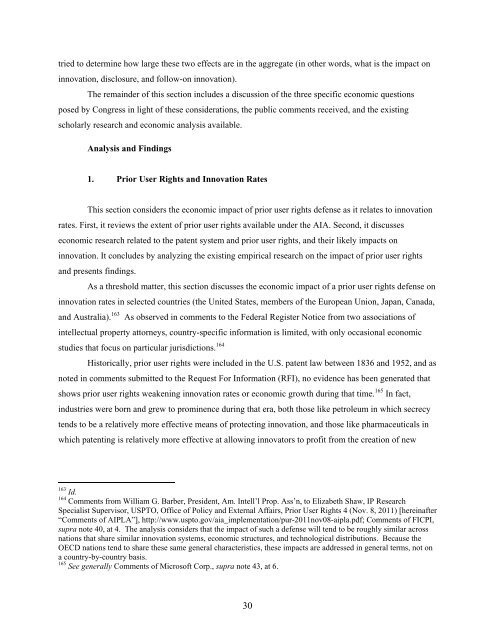Prior User Rights Study Report to Congress - America Invents Act
Prior User Rights Study Report to Congress - America Invents Act
Prior User Rights Study Report to Congress - America Invents Act
Create successful ePaper yourself
Turn your PDF publications into a flip-book with our unique Google optimized e-Paper software.
tried <strong>to</strong> determine how large these two effects are in the aggregate (in other words, what is the impact oninnovation, disclosure, and follow-on innovation).The remainder of this section includes a discussion of the three specific economic questionsposed by <strong>Congress</strong> in light of these considerations, the public comments received, and the existingscholarly research and economic analysis available.Analysis and Findings1. <strong>Prior</strong> <strong>User</strong> <strong>Rights</strong> and Innovation RatesThis section considers the economic impact of prior user rights defense as it relates <strong>to</strong> innovationrates. First, it reviews the extent of prior user rights available under the AIA. Second, it discusseseconomic research related <strong>to</strong> the patent system and prior user rights, and their likely impacts oninnovation. It concludes by analyzing the existing empirical research on the impact of prior user rightsand presents findings.As a threshold matter, this section discusses the economic impact of a prior user rights defense oninnovation rates in selected countries (the United States, members of the European Union, Japan, Canada,and Australia). 163 As observed in comments <strong>to</strong> the Federal Register Notice from two associations ofintellectual property at<strong>to</strong>rneys, country-specific information is limited, with only occasional economicstudies that focus on particular jurisdictions. 164His<strong>to</strong>rically, prior user rights were included in the U.S. patent law between 1836 and 1952, and asnoted in comments submitted <strong>to</strong> the Request For Information (RFI), no evidence has been generated thatshows prior user rights weakening innovation rates or economic growth during that time. 165 In fact,industries were born and grew <strong>to</strong> prominence during that era, both those like petroleum in which secrecytends <strong>to</strong> be a relatively more effective means of protecting innovation, and those like pharmaceuticals inwhich patenting is relatively more effective at allowing innova<strong>to</strong>rs <strong>to</strong> profit from the creation of new163 Id.164 Comments from William G. Barber, President, Am. Intell’l Prop. Ass’n, <strong>to</strong> Elizabeth Shaw, IP ResearchSpecialist Supervisor, USPTO, Office of Policy and External Affairs, <strong>Prior</strong> <strong>User</strong> <strong>Rights</strong> 4 (Nov. 8, 2011) [hereinafter“Comments of AIPLA”], http://www.usp<strong>to</strong>.gov/aia_implementation/pur-2011nov08-aipla.pdf; Comments of FICPI,supra note 40, at 4. The analysis considers that the impact of such a defense will tend <strong>to</strong> be roughly similar acrossnations that share similar innovation systems, economic structures, and technological distributions. Because theOECD nations tend <strong>to</strong> share these same general characteristics, these impacts are addressed in general terms, not ona country-by-country basis.165 See generally Comments of Microsoft Corp., supra note 43, at 6.30


